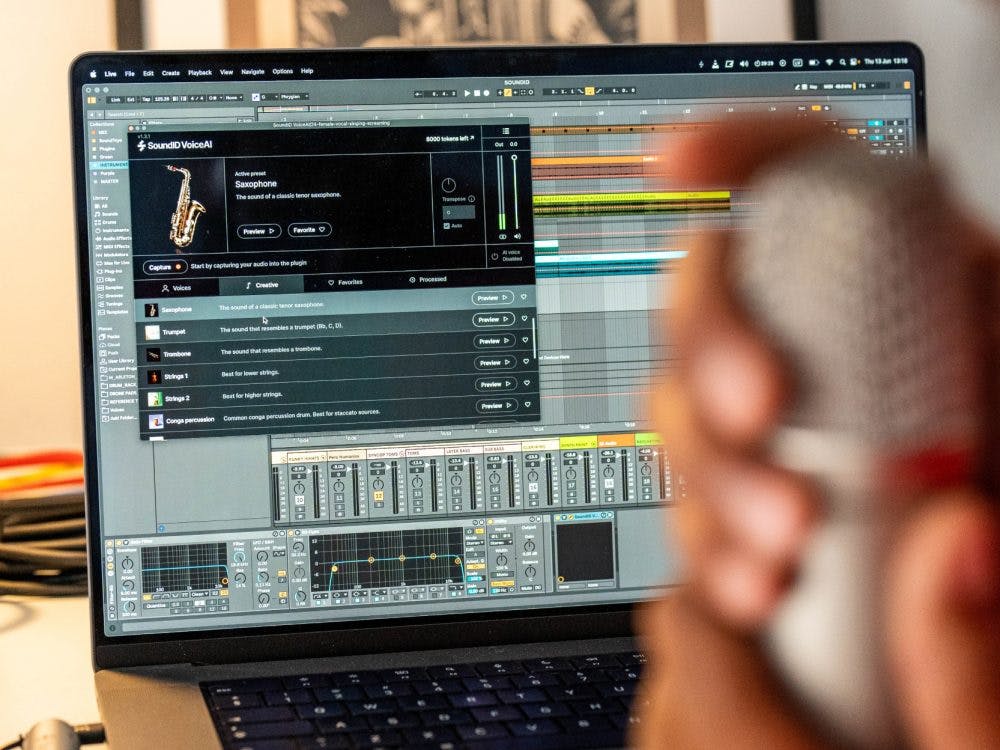AI helps artists experiment with sound by removing technical barriers that traditionally required years of audio engineering knowledge. Artificial intelligence music tools automate complex processes like mixing, mastering, and sound design, allowing creators to focus on their artistic vision rather than learning intricate software controls. These AI-powered systems can transform vocals into instruments, generate unique soundscapes, and provide intelligent mixing assistance, making advanced sound manipulation accessible to artists at any skill level.
What does AI-powered sound experimentation mean for modern artists?
AI-powered sound experimentation represents a fundamental shift in how artists approach music creation software. Instead of spending months learning complex digital audio workstations and audio engineering principles, artists can now direct their creative energy towards exploring sonic possibilities.
This technology simplifies advanced audio processes that once required extensive technical knowledge. Artists can now hum a melody and instantly transform it into orchestral instruments, create rich backing vocals from a single voice recording, or apply professional-grade processing to rough demos. The AI handles the technical implementation whilst you maintain complete creative control.
Modern AI music production tools understand musical context and can make intelligent decisions about sound processing. They analyse your input and apply appropriate transformations based on musical principles, effectively serving as a knowledgeable collaborator rather than just a tool.
What are the main technical barriers that limit sound experimentation?
Traditional music production presents several obstacles that prevent artists from fully exploring their creative ideas. Complex DAW interfaces often overwhelm newcomers with hundreds of parameters, routing options, and technical settings that require significant time investment to master.
Audio engineering knowledge requirements create another substantial barrier. Understanding concepts like EQ curves, compression ratios, reverb parameters, and mixing techniques typically takes years to develop. Many artists abandon promising musical ideas because they lack the technical skills to realise their vision.
Equipment costs compound these challenges. Professional-grade plugins, sample libraries, and processing tools can cost thousands of pounds, making experimentation financially prohibitive for many creators. Time-consuming manual processes also disrupt creative flow, forcing artists to switch between creative and technical mindsets repeatedly during production sessions.
How does AI remove the complexity from music production workflows?
AI streamlines music production by automating the technical aspects that typically slow down creative workflows. Sound design AI can analyse your musical intent and apply appropriate processing without requiring you to understand the underlying technical parameters.
Intelligent mixing assistants automatically balance levels, apply EQ corrections, and manage dynamics based on the musical content. These systems recognise different instrument types and vocal characteristics, applying genre-appropriate processing that would typically require extensive manual adjustment.
AI-powered mastering tools can analyse your mix and apply professional-grade finalisation processing in seconds rather than hours. They understand loudness standards, frequency balance, and dynamic range requirements across different musical styles, delivering results that previously required specialist expertise.
Voice processing represents another area where AI eliminates complexity. Advanced vocal plugins can transform recorded voices into different characters, genders, or even instruments whilst maintaining natural-sounding results through sophisticated analysis of pitch, formants, and timbre.
What types of AI tools help artists create unique sounds?
Generative audio tools lead the field of creative audio tools, creating entirely new musical content based on your input parameters. These systems can generate melodies, harmonies, and rhythmic patterns that serve as starting points for further development.
Intelligent mixing assistants analyse your tracks and provide contextual suggestions for improvement. They can identify frequency conflicts, suggest compression settings, and recommend spatial positioning for different elements in your mix.
| Tool Type | Primary Function | Best Use Cases |
|---|---|---|
| Voice Processing Plugins | Transform vocal characteristics | Creating backing vocals, character voices, vocal instruments |
| Generative Instruments | Create new musical content | Melody generation, harmonic exploration, rhythm creation |
| Adaptive Processors | Intelligent audio enhancement | Dynamic EQ, smart compression, contextual effects |
| Sound Design Systems | Generate unique textures | Atmospheric sounds, experimental textures, sonic landscapes |
Voice processing plugins offer particularly powerful creative possibilities. Modern AI-driven vocal tools can transform a single voice recording into multiple distinct characters, create realistic backing vocals, or even convert vocal melodies into instrumental parts. These tools analyse the harmonic content and timing of your original recording to maintain musical coherence whilst applying dramatic transformations.
Adaptive sound design software responds to your musical context, generating textures and atmospheres that complement your existing material. These systems understand musical key, tempo, and energy levels, creating sounds that integrate naturally with your composition.
How can artists balance AI assistance with personal creativity?
The key to successful AI integration lies in treating these tools as creative partners rather than replacements for artistic decision-making. Use AI to handle technical implementation whilst you focus on musical choices, emotional expression, and overall artistic direction.
Start with your creative vision and let AI help you achieve it more efficiently. Rather than allowing AI to make creative decisions for you, use it to explore possibilities you might not have considered or to quickly test different approaches to your musical ideas.
Maintain control over the final output by treating AI suggestions as starting points for further refinement. Most AI music production tools allow you to adjust and customise their output, enabling you to shape the results according to your artistic preferences.
Consider establishing a workflow where AI handles the initial heavy lifting, then you apply your artistic judgement to refine and personalise the results. This approach maximises efficiency whilst ensuring your unique creative voice remains prominent in the final work.
The future of music creation lies in this collaborative relationship between human creativity and artificial intelligence. By embracing AI as a powerful creative assistant, you can expand your sonic possibilities whilst maintaining the personal touch that makes your music distinctive. We’re committed to developing tools that enhance rather than replace human creativity, helping you bring your musical visions to life more effectively than ever before.
If you’re ready to get started, check out VoiceAI today.



